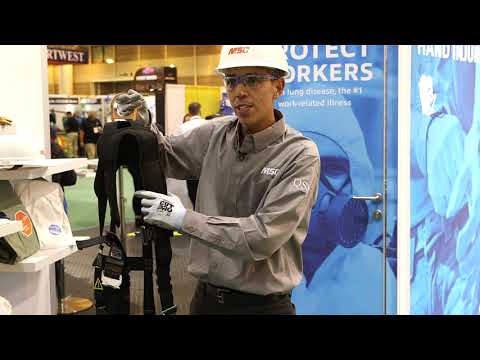Proper anchoring and use of fall protection systems can mean the difference between a minor hiccup on the job and a fatal fall. Here’s a plan for implementing tie-off best practices in your safety awareness and safety culture efforts.
Fall protection remains the No. 1 violation on the Occupational Safety and Health Administration’s top 10 list—where it’s been for nine consecutive years.
What can a business do to better protect its workers from becoming an OSHA fall statistic? Focus on safety moments that can really raise the awareness of a dire safety issue and improve a company’s safety culture overall.
The Problem: Workers Ignore Anchorage Best Practices
Falls from height are the fourth-leading cause of injuries that result in five or more lost workdays among general industry businesses (and the No. 1 cause in the construction sector), according to Liberty Mutual’s 2019 Safety Index. Across all industries, these falls cost businesses almost $5 billion collectively, Liberty Mutual reports.
“If the attachment point does not hold, your fall restraint becomes utterly useless and, in some cases, worse off for the employee,” someone noted not long ago in a comment to our article about the 2019 OSHA top 10 list, which detailed the continued prevalence of fall violations.
The smart use of anchors and fall protection systems when tying off really can’t be overstated, as the OSHA rules require 100 percent tie-off for general industry at any height of more than 4 feet.
“It doesn’t seem that high,” acknowledges MSC Safety Specialist Bruno Cunha. But he says workers and shop managers still regularly voice surprise when he shares that threshold for applying protective measures.
What’s more, adds Damon Cassell, who also is a safety specialist at MSC, it’s quite common to see workers simply not tie off or to tie off improperly at heights much greater than the OSHA limit.
The Challenge: The Need to Instill Common Sense in Fall Safety
“For a fall protection system to be effective, the anchorage used must be strong enough to support the person wearing it,” explains an American Society of Safety Professionals article. “In many cases, workers think that connecting to anything on the building is better than not connecting at all. Without testing the anchorage strength, such a connection may not provide the proper support.”
Tie-offs do require some common sense by workers, Cassell says, but they also demand it of the safety team.
For starters, no one should tie off with a line that’s longer than the drop height, he says. Seems obvious, right? Yet, that happens more often than people would think, Cassell warns.
For the safety team, the goal must be to make it as simple as possible for workers to do the right thing, the safe thing, when it comes to using personal protective equipment and other fall protection gear, he says.
Here’s what OSHA says about anchors in 29 CFR 1926.502, specifically parts (d)(15) and (d)(15)(i): “Anchorages used for attachment of personal fall arrest equipment shall be independent of any anchorage being used to support or suspend platforms and capable of supporting at least 5,000 pounds per employee attached, or shall be designed, installed, and used … as part of a complete personal fall arrest system, which maintains a safety factor of at least two.”
Learn the equation for calculating fall distance in our fall protection infographic.
Your Safety Moment: Use Numbers to Make Fall Dangers Real
One way to make the danger of a fall resonate with workers is to dig into the OSHA rule and explain the factors of force, weight and distance at play when someone falls.
First, the force of a drop, created by gravity’s pull, is several times a worker’s weight. “The forces incurred during a fall of a 220-pound worker who is utilizing a fall arrest system could be between 900 and 1,800 pounds,” notes an article in Occupational Health & Safety magazine.
Pretty quickly, it’s easy to see why a fall can severely injure or even kill someone. It also explains why OSHA wants anchors to sustain 5,000 pounds of force or for an anchor in a system to handle double the calculated force.
Break down these numbers to your employees and consider potentially showing them what happens to, say, a large watermelon dropped from heights of 4 feet or more.
This makes the potential risk real.
Second, there is a window of weight for use of anchors: generally, more than 130 pounds and less than 410 pounds—including the weight of the worker, equipment and tools.
Below that window, PPE might not fit securely enough and protective systems might not activate appropriately. Above it, there can be issues with anchor integrity and also with the appropriate restraint shock absorption because of the higher force generated during a fall, even with line arrest systems.
More Help: Three More Ways to Reduce the Risk of Falls
Finally, here are some additional things your business can do to make compliance with fall protection standards easier.
Consider placing fall communications anywhere where workers might use ladders or platforms to undertake work or machine maintenance. Also consider placing signs wherever the company stores and checks out harnesses to team members.
The OSHA rules require both training certification to use harnesses and then inspections of each harness every time a worker dons one.
· Become an expert in the OSHA guardrail requirements.
For workplaces, these include handrails, stair rails, midrails and top rails. The safety agency provides details and diagrams about guardrails in 29 CFR 1910.29.
Our story on guardrails also defines each and explains the flexibility that businesses have in mixing and matching equipment and gear to create fall protection systems.
Given the potential for lost workdays—and even the death of a worker—from a fall, what does your company do to ensure best practices when tying off and using anchors?







